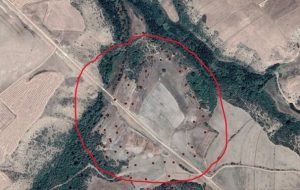Archaeologists uncover prehistoric relics in northern Iran
TEHRAN – A team of archaeologists has recently unearthed significant artifacts and architectural remains from prehistoric times in the Chahardangeh district of Sari, located in eastern part of Mazandaran province, northern Iran. The discoveries include pottery fragments, stone tools, bones, charcoal, burial evidence, hearths, and remnants of stone and mudbrick structures. These findings shed light

TEHRAN – A team of archaeologists has recently unearthed significant artifacts and architectural remains from prehistoric times in the Chahardangeh district of Sari, located in eastern part of Mazandaran province, northern Iran.
The discoveries include pottery fragments, stone tools, bones, charcoal, burial evidence, hearths, and remnants of stone and mudbrick structures. These findings shed light on ancient cultural and economic practices and are expected to reveal insights into even older layers from the Chalcolithic and Neolithic periods, ISNA reported.
A region of cultural connectivity
The Chahardangeh district, part of the larger Hezar-Jarib region, serves as a critical juncture between the northern plains of eastern Mazandaran and the southern plains of Semnan, Damghan, and Shahroud. This geographical positioning highlights the site’s importance in studying cultural interactions across the Central Alborz Mountains during prehistoric times.
Collaborative research efforts
The excavations are being conducted at the “Qaleh Seri Terkam” archaeological site as part of a collaborative agreement between the University of Mazandaran and the provincial department for cultural heritage, tourism, and handicrafts.

Supported by the Iranian Research Institute for Cultural Heritage and Tourism, the first phase, completed in October, involved 48 test trenches to determine the boundaries and protection zones of the site.
According to Dr. Rahmat Abbasnejad-Seresti, head of the archaeological team and a faculty member at the University of Mazandaran, the boundaries will soon be formally approved and communicated to relevant authorities.
The second phase, focused on stratigraphic excavation, commenced recently and will continue through December 5. The archaeological work involves experts from various universities, including Tehran University and the University of Art Isfahan, along with advanced graduate students.
Unveiling the past
Abbasnejad emphasized that Qaleh Seri Terkam, situated on a 1,300-meter-high mound near the Terkam River, holds clues to settlement patterns in the Chahardangeh region dating back to the 5th millennium BC. Despite previous limited research, the new findings promise to deepen understanding of key periods such as the Neolithic, Chalcolithic, Bronze, and Iron Ages.

Preliminary findings include vibrant red and ochre-painted pottery from the Chalcolithic era, featuring geometric designs in black and dark brown. Bronze Age pottery exhibits a darker gray spectrum, while Iron Age ceramics are abundant in light and dark gray hues, the archaeologist explained.
Broader objectives
The excavation aims to conduct thorough stratigraphy and chronological studies, analyze collected artifacts, and explore interactions between cultural and environmental shifts across historical periods. The team is also gathering botanical and faunal samples for paleoecological and micromorphological studies.

Innovative techniques, such as short-range photogrammetry for aerial mapping, are aiding the research. The findings are expected to inform strategic cultural heritage programs in Mazandaran and support cultural tourism initiatives, the archaeologist explained.
Future prospects
Abbasnejad hopes the project, which has received enthusiastic support from local officials, will continue in the coming years. “Its outcomes will contribute to the academic understanding of Iran’s prehistoric heritage and enhance cultural tourism efforts in Mazandaran.”
The project underscores the collaborative efforts of academic and cultural institutions in preserving and exploring Iran’s rich archaeological legacy.
This report is based on information provided by Iran’s Cultural Heritage, Tourism, and Handicrafts Department and the University of Mazandaran.
AM
